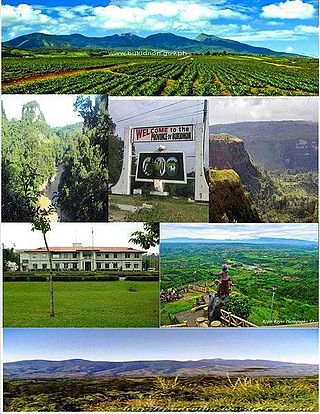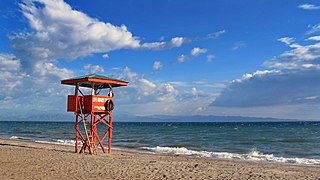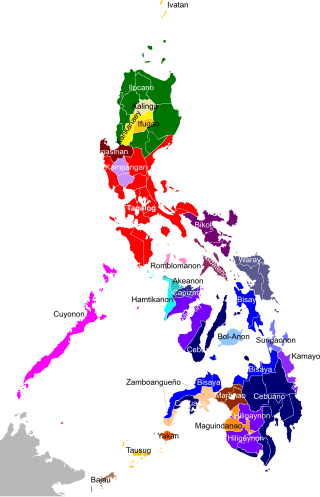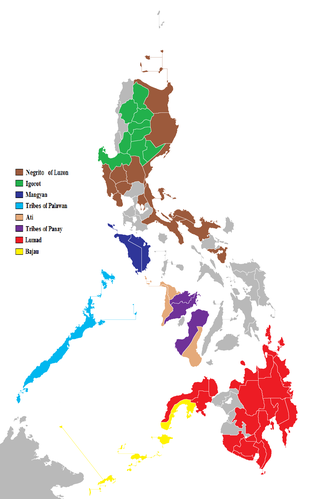
Mindanao is the second-largest island in the Philippines, after Luzon, and seventh-most populous island in the world. Located in the southern region of the archipelago, the island is part of an island group of the same name that also includes its adjacent islands, notably the Sulu Archipelago. According to the 2020 census, Mindanao had a population of 26,252,442, while the entire island group had an estimated population of 27,021,036.

Northern Mindanao is an administrative region in the Philippines, designated as Region X. It comprises five provinces: Bukidnon, Camiguin, Misamis Occidental, Misamis Oriental, and Lanao del Norte, and two cities classified as highly urbanized, all occupying the north-central part of Mindanao island, and the island-province of Camiguin. The regional center and largest city is Cagayan de Oro. Lanao del Norte was transferred to Northern Mindanao from Region XII by virtue of Executive Order No. 36 in September 2001.

Bukidnon, officially the Province of Bukidnon, is a landlocked province in the Philippines located in the Northern Mindanao region. Its capital is the city of Malaybalay while Valencia is the largest city. The province borders, clockwise from the north, Misamis Oriental, Agusan del Sur, Davao del Norte, Cotabato, Lanao del Sur, and Lanao del Norte. According to the 2020 census, the province is inhabited by 1,541,308 residents. The province is composed of 2 component cities and 20 municipalities. It is the third largest province in the country in terms of total area of jurisdiction behind Palawan and Isabela respectively.

Davao del Sur, officially the Province of Davao del Sur, is a province in the Philippines located in the Davao Region in Mindanao. Its capital is Digos. Davao City is the largest city in terms of area and population within the province's jurisdiction, yet it is administratively independent from the province; as such, Davao City is only grouped for geographical and statistical purposes and serves as the regional center of Davao Region.

Soccsksargen, formerly known as Central Mindanao, is an administrative region of the Philippines, designated as Region XII. Located in south-central Mindanao, its name is an acronym that stands for the region's four provinces and one highly urbanized city. The regional center is in Koronadal, located in the province of Cotabato del Sur, and the center of commerce and industry is General Santos, which is the most populous city in the region.

Maguindanaon, or Magindanawn is an Austronesian language spoken by Maguindanaon people who form majority of the population of eponymous provinces of Maguindanao del Norte and Maguindanao del Sur in the Philippines. It is also spoken by sizable minorities in different parts of Mindanao such as the cities of Zamboanga, Davao, General Santos, and Cagayan de Oro, and the provinces of North Cotabato, Sultan Kudarat, South Cotabato, Sarangani, Zamboanga del Sur, Zamboanga Sibugay, Davao del Sur, Davao Occidental, Bukidnon as well as Metro Manila. As of 2020, the language is ranked to be the ninth leading language spoken at home in the Philippines with only 365,032 households still speaking the language.
The Central Philippine languages are the most geographically widespread demonstrated group of languages in the Philippines, being spoken in southern Luzon, Visayas, Mindanao, and Sulu. They are also the most populous, including Tagalog, Bikol, and the major Visayan languages Cebuano, Hiligaynon, Waray, Kinaray-a, and Tausug, with some forty languages all together.

The Philippines is inhabited by more than 182 ethnolinguistic groups, many of which are classified as "Indigenous Peoples" under the country's Indigenous Peoples' Rights Act of 1997. Traditionally-Muslim peoples from the southernmost island group of Mindanao are usually categorized together as Moro peoples, whether they are classified as Indigenous peoples or not. About 142 are classified as non-Muslim Indigenous people groups, and about 19 ethnolinguistic groups are classified as neither Indigenous nor Moro. Various migrant groups have also had a significant presence throughout the country's history.

The Lumad are a group of Austronesian indigenous peoples in the southern Philippines. It is a Cebuano term meaning "native" or "indigenous". The term is short for Katawhang Lumad, the autonym officially adopted by the delegates of the Lumad Mindanao Peoples Federation (LMPF) founding assembly on 26 June 1986 at the Guadalupe Formation Center, Balindog, Kidapawan, Cotabato. Usage of the term was accepted in Philippine jurisprudence when President Corazon Aquino signed into law Republic Act 6734, where the word was used in Art. XIII sec. 8(2) to distinguish Lumad ethnic communities from the islands of Mindanao.

The Christian And Missionary Alliance Churches of the Philippines (CAMACOP) is a Christian evangelical group in the Philippines that originated from The Christian and Missionary Alliance (C&MA). It is one of the largest evangelical groups in the Philippines.

The indigenous peoples of the Philippines are ethnolinguistic groups or subgroups that maintain partial isolation or independence throughout the colonial era, and have retained much of their traditional pre-colonial culture and practices.
The Manobo are an indigenous peoples from Mindanao in the Philippines, whose core lands cover most of the Mindanao island group, from Sarangani island into the Mindanao mainland in the regions of Agusan, Davao, Bukidnon, Surigao, Misamis, and Cotabato. The Manobo are considered the most diverse among the many indigenous peoples of the Philippines, with the largest number of subgroups within its family of languages. The Philippine Statistics Authority listed 644,904 persons as Manobo in its 2020 Census of Population and Housing.
Sarangani is a Manobo language of the Davao Region of Mindanao in the Philippines.
Agusan is a Manobo language of northeastern Mindanao in the Philippines.
Higaonon is a Manobo language spoken on the island of Mindanao in the Philippines. It is partially (80%) intelligible with Binukid.

Tagabawa is a Manobo language of Davao City and Mount Apo in Mindanao, the Philippines. Tagabawa is spoken in Cotabato and Davao del Sur provinces, and on the slopes of Mount Apo west of Davao City, The language is spoken by the Bagobo Tagabawa people.
Ata is a Manobo language of northeastern Mindanao of the Philippines. It is spoken in northwest Davao del Norte province, southeast Bukidnon province, Davao de Oro province, and Davao del Sur province.
Matigsalug is a Manobo language of Mindanao in the Philippines. It belongs to the Austronesian language family.
Ilianen is a Manobo language of Mindanao in the Philippines.
Western Bukidnon Manobo is a Manobo language of Mindanao in the Philippines.











